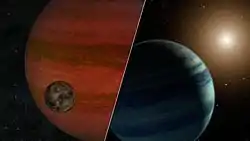MOA-2011-BLG-262L
MOA-2011-BLG-262L is an astronomical object of uncertain nature with an orbiting companion, detected through the gravitational microlensing event MOA-2011-BLG-262 in the constellation Sagittarius. Two different models fit the observation equally well - an object of ~3.2 MJ, likely a rogue planet, at a distance of about 0.56 kiloparsecs (1,800 light-years) and orbited by a ~0.47 M🜨 exomoon; or an object of ~0.11 M☉, likely a red dwarf star, at a distance of about 7.2 kiloparsecs (23,000 light-years) in the galactic bulge, and orbited by a ~17 M🜨 planet. The discovery team considers the latter scenario to be more likely.[2][3]
 Artist's impression showing the two models of the MOA-2011-BLG-262L system | |
| Observation data Epoch J2000 Equinox J2000 | |
|---|---|
| Constellation | Sagittarius[1] |
| Right ascension | 18h 00m 23.48s[2] |
| Declination | −31° 14′ 42.93″[2] |
| Astrometry | |
| Distance | ~1,800 or ~23,000 ly (~560 or ~7,200[2] pc) |
| Details[2] | |
| Mass | 0.11+0.21 −0.06 M☉ |
| Mass | 3.2 MJup |
| Database references | |
| SIMBAD | data |
Planetary system
| Companion (in order from star) |
Mass | Semimajor axis (AU) |
Orbital period (days) |
Eccentricity | Inclination | Radius |
|---|---|---|---|---|---|---|
| b | ~17 or ~0.47 M🜨 | ~0.95 or ~0.13 | — | — | — | — |
References
- "Finding the constellation which contains given sky coordinates". djm.cc. 2 August 2008.
- Bennett, D.P.; Batista, V.; et al. (13 December 2013). "A Sub-Earth-Mass Moon Orbiting a Gas Giant Primary or a High Velocity Planetary System in the Galactic Bulge". The Astrophysical Journal. 785 (2): 155. arXiv:1312.3951. Bibcode:2014ApJ...785..155B. doi:10.1088/0004-637X/785/2/155. S2CID 118327512.
- Clavin, Whitney (10 April 2014). "Faraway Moon or Faint Star? Possible Exomoon Found". NASA. Archived from the original on 12 April 2014. Retrieved 19 February 2023.
This article is issued from Wikipedia. The text is licensed under Creative Commons - Attribution - Sharealike. Additional terms may apply for the media files.


